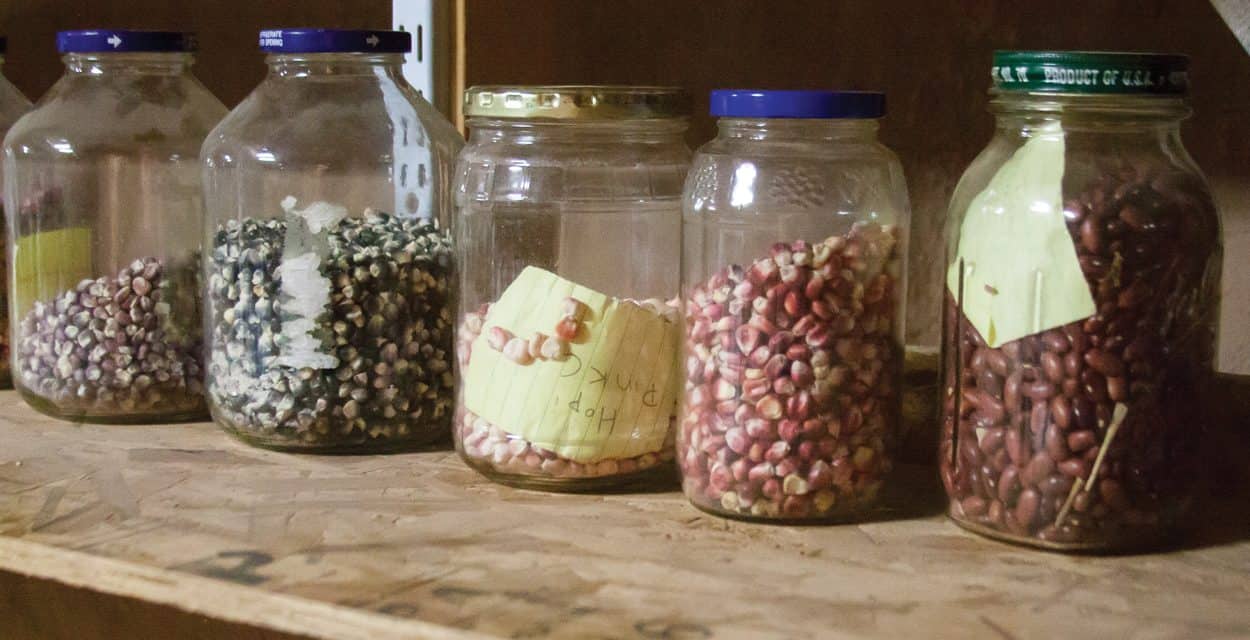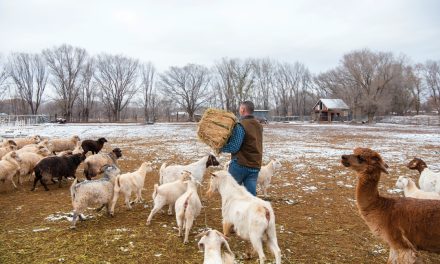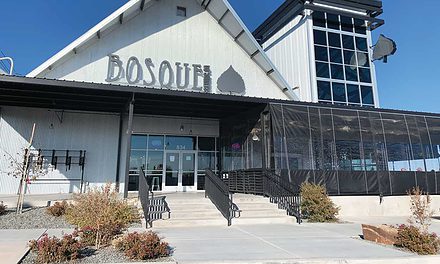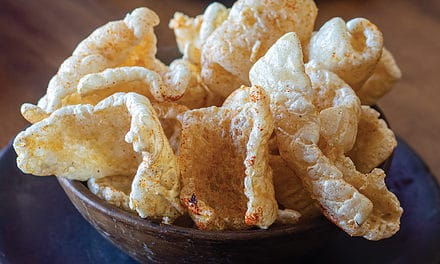The Rocky Mountain Seed Alliance Grain School Is Coming to Albuquerque on July 26 – 27
By Pamela Walker

Ron Boyd, with his wife, Debora Clare, has been growing fruit and vegetables in Alcalde for twenty years, currently cultivating about twelve acres. “Our practices have always been beyond organic, including biodynamic and certified organic for about twelve years,” he says. Boyd is also a seed producer. About six years ago, he began propagating seeds not just to save for his own farming, but also to sell to Baker Creek Heirloom Seed Company, in Mansfield, Missouri, which is recognized for its stringent standards in acquiring and purveying nearly 2,000 varieties of fruit, vegetable, and herb seeds, the largest selection in the United States. The seeds Ron sells to Baker Creek include several varieties of corn, beans, peppers, melons, and onions.
“I like food,” Boyd says, “and in a world that sometimes feels kind of crazy, keeping my head and heart close to the soil and seed makes me feel like a pretty fortunate man doing what I can for a planet I think is a pretty nice place.”
Recently, Boyd ventured for the first time into grain seed production. In January 2018, he, along with several expert gardeners from Santa Fe, attended an annual grain school organized by the Rocky Mountain Seed Alliance (RMSA) at the University of Colorado – Colorado Springs (UCCS). This course focuses on ancient grains, grains that predate by about ten thousand years the less nutritious, less flavorful wheat developed for industrial farming and milling. Attending it inspired Boyd and the gardeners to work as a team in partnership with RMSA and do trial plantings of einkorn, emmer, kamut, turkey red, spelt, and other ancient grains on two small plots at Los Luceros, a state historic site in Alcalde.
RMSA very soon – on July 26th to 27th – will host its first New Mexico grain school, in Albuquerque at the Albuquerque Museum. The main goal of RMSA’s grain schools and production trials is to create networks of farmers, millers, brewers, and bakers and chefs and restore ancient grains to their traditional place in local food communities. Boyd and others involved in the Los Luceros grain trials will be among the Albuquerque grain school participants.
Boyd has always grown modern varieties of rye, wheat, and oats as cover crops, growing ancient grains and propagating grain seeds was mainly just an occasional thought before the RMSA grain school drew him to UCCS. “The word about old-time and small grains had been circulating around markets and around Baker’s Heirloom Seeds for a while,” Boyd says, “and then it was really grain school that got me into it.”
Now nearing sixty-three, Boyd can’t remember the first time he saved seed. “It was just the obvious thing to do,” he says. He grew up east of Pueblo, Colorado, and though his parents weren’t farmers, they kept a milk cow, rabbits, chickens, and hogs, and Ron spent most of his summers working in the fields of local farms. “It just always seemed like if you’re going to plant again, why aren’t you going to keep the seed? I mean, a seed store was a cool place, but you had to have money, and saving seed is free.”
Boyd’s attitude and habit of saving seed was once commonplace, a necessity, in fact, for most of the twelve thousand years or so that people have engaged in agriculture. The seed saving habit allowed many varieties of locally adapted plants to thrive and kept genetic diversity strong. But a scant century ago, commercial seed companies arose, mainly to develop and promote more predictable and higher-yielding hybrid plants, especially, in the beginning, corn, and farmers began buying more and more hybrid seed and saving their own seed less and less. Almost concurrently, the scale of farming shifted from small to large and from diverse crops to only a few. Indigenous and other traditional agricultural communities, such as the Amish and Mennonites, however, are among the main exceptions to this arc. They have generally held to seed saving and small-scale, diverse farming that so many others abandoned.
But seed saving is making a comeback. Largely neglected even within the local food movement until fairly recently, seed saving has become a pressing issue. Alarms are sounding and awareness is growing that seeds are imperiled by two main forces.
One force is the increasing loss of plant varieties and genetic diversity all over the planet. In the last century alone, 94 percent of traditional, open-pollinated vegetable and fruit varieties were lost, and only five years into the 21st century, the United Nations Food and Agriculture Organization reported a 75 percent loss of garden vegetables worldwide. The loss continues. Just this year, the UN reports that out of a total of about 283,000 existing plant species, just slightly more than 6,000 have been cultivated for food, with fewer than 200 of these in globally substantial production. And of these 200, a mere nine plants – sugar cane, maize, rice, wheat, potatoes, soybeans, oil-palm fruit, sugar beet, and cassava – amount, in aggregate, to about 66 percent of all crop production, with much of this used not to feed people but livestock or to produce ethanol.
The second imperiling force is the acceleration of corporate control over seeds stemming from a 1980 U. S. Supreme Court decision that allows companies to patent plants and thereby own them, genetically alter them, and sue people, including farmers, for infringement. Corporations have done all of these things and continue to do them. And their scope and power is increasing. As a result of a series of mergers, four global seed-and-chemical corporations (Bayer, BASF, ChemChina, and Corteva) now control more than 60 percent of all seed sales. Chef Dan Barber in a recent New York Times article calls this a “genetic land grab.”
This predicament, says writer and farmer Janisse Ray in her book The Seed Underground: a Growing Revolution to Save Food, has brought the belated realization that we “do not have control of seeds, which are the crux of our food supply.” What this loss of control requires is nothing less than a revolution, Ray says, a revolution to take back the plant commons by as many people as possible saving and propagating seeds everywhere and circulating and exchanging them.
The same sense of urgency and revolutionary fervor informs the RMSA in its seed and grain schools, production trials, and other projects. Only five years old, the organization has already created a network of three hundred seed saving groups and individuals, and has held two conferences, or “seed summits” in Santa Fe. The first occurred in 2017, the second this past February, drawing seed activists from New Mexico and throughout the mountain west and, this year, also from New York and even Greece and Zimbabwe.
“We are people of the pinch,” says Bill McDorman, a professional seedsman and co-founder of the RMSA. Having developed and operated several successful seed businesses and worked as executive director of Native Seeds/SEARCH, the Tucson-based seed conservancy founded by MacArthur recipient Gary Paul Nabhan, McDorman says the idea for an organization devoted to teaching seed saving and creating seed saving networks came to him as a kind of epiphany. “I woke up one night about 3 in the morning and sat up in bed, thinking seed school! We’ve got to teach this stuff! I’m going back to the old way of doing it. To have everybody everywhere saving and storing and sharing their own seeds regionally is the way it has always been done.”
The RMSA is drawn to New Mexico for some of its projects because to a greater extent than some other places, the state is a seedbed of seedbeds rooted in centuries of indigenous and Hispanic small-scale farming — a rich source of traditional seeds themselves and of seed knowledge and expertise. Not only is New Mexico home to many farmers like Boyd who propagate traditional seeds, whether for their own growing purposes or to sell commercially or to do both, but it is also home to countless generations of indigenous gardeners and farmers who have propagated seeds and kept traditional foods alive even as these ancient practices sometimes waned and seemed to be dying. Tesuque Pueblo, with its certified organic farm and seed bank, is a prominent example, and was featured in both of RMSA’s seed summit field trips and conference presentations.
Tesuque land has been farmed since about the thirteenth century, but by the late twentieth century, the main crop was alfalfa, and the community began to regret the loss of centuries-old foods. “Farmers were aging, and when the main remaining farmer died, his seeds went dormant and many perished,” according to Clayton Brascoupe, a Tesuque community member and founder of the Traditional Native American Farmers Association. In part through Brascoupe’s leadership, in 1996, Tesuque started teaching seed saving. “Seeds are part of our family,” Brascoupe says. “Sometimes they get lost, and we try to find them and renew that relationship and take care of them.”
The forty-acre farm currently produces cherries, plums, apples, peaches, and apricots from about 750 trees. Medicinal herbs grow in the orchard understory, most of which the pueblo sells to Herbs Etc., in Santa Fe. The farm also produces corn, beans, chiles, potatoes, amaranth, and quinoa, with the produce going to elders and other community members, some of whom cultivate small plots of their own. Seeds are sold to seed businesses and to projects such as Native Seeds/SEARCH.
In 2005, the pueblo began a seed bank in the cargo area of a box truck, storing seeds in a jumble of bags and plastic buckets. That same year, it also hired as its agricultural director Emigdio Ballon, a Bolivian plant geneticist of Quechua ancestry who brings both contemporary and ancient knowledge to developing the farm and seed bank.
An adobe, solar-powered seed bank was completed in 2014 and houses over a thousand varieties in its constantly cool, dry underground storage room. Here, the hand-cleaned and hand-sorted seeds are placed on shelves in bags of muslin, burlap, and plastic, in coffee cans and buckets, in manila envelopes large and small, and in glass jars of various sizes and shapes, all identified with hand-written labels. “We are seeds being planted into the womb of mother earth,” Ballon says. “Seeds need attention like little babies.”
Ballon participates in the annual RMSA – UCCS grain schools, sharing his expertise in quinoa and amaranth especially, as well as his passionate devotion to seed stewardship. He enjoys relating his grandfather’s counsel about seeds. “It is better to have seeds in your pockets than money,” his grandfather said. “Money, you can’t eat. But seeds? Seeds you can eat.”
With the upcoming grain school on July 26th – 27th in Albuquerque, RMSA’s work with New Mexico growers and seed stewards continues and expands.
Boyd, who has always enjoyed sharing information about farming and, with his wife, was recognized as educator of the year at the 2018 New Mexico Organic Farming Conference, looks forward to this new arena of education that RMSA is making possible.
“I’d love to see more folks with the opportunity to diversify their rotations and contribute to what’s been called the staff of life,” he says. “It’s a delight to participate with others to bring life to our food.”
Que viva la revolucion de las semillas!

Ron Boyd, Photo by Pamela Walker

Emigdio Ballon at the Tesuque Seed Bank, Photo by Pamela Walker

Ancient grains being planted at Los Luceros, Photo by Pamela Walker

Ron Boyd, Photo by Pamela Walker
Rocky Mountain Seed Alliance Grain School in Albuquerque
July 26 – 27, 2019 at the Albuquerque Museum
2000 Mountain Road NW, Albuquerque
Presented by RMSA in partnership with Seed Broadcast, Garden’s Edge, and Land Arts of the American West.
Albuquerque Seed Library
South Broadway Cultural Center Library
1025 Broadway SE, Albuquerque
Embudo Valley Library Seed Library
217A Hwy 75, Dixon
Santa Fe Seed Library
Santa Fe Public Library Southside Branch
6599 Jaguar Dr. Santa Fe
Edible celebrates New Mexico's food culture, season by season. We believe that knowing where our food comes from is a powerful thing. With our high-quality, aesthetically pleasing and informative publication, we inspire readers to support and celebrate the growers, producers, chefs, beverage and food artisans, and other food professionals in our community.

















